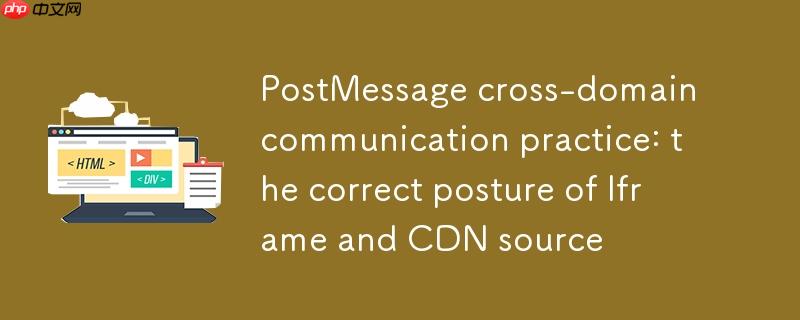
postMessage API是HTML5引入的一项强大功能,它允许来自不同源(协议、域名、端口任意一项不同)的脚本之间安全地发送消息。这在处理Iframe、弹出窗口或Web Workers之间的通信时尤为重要。postMessage方法通常在目标窗口对象上调用,其基本语法如下:
targetWindow.postMessage(message, targetOrigin);
在接收端,目标窗口需要通过监听message事件来接收消息:
window.addEventListener('message', function(event) {
// event.data 包含发送的数据
// event.origin 包含发送消息的窗口的源
// event.source 包含发送消息的窗口对象
// 强烈建议在此处验证 event.origin,以确保消息来自受信任的源
if (event.origin !== 'http://your-expected-origin.com') {
return; // 拒绝处理来自非信任源的消息
}
console.log("Received message:", event.data);
}, false);当Iframe的src指向一个CDN资源时,例如http://d34gxw3jqlasaag.cloudfront.net/sampletemplate2.html,主应用(假设其源为http://localhost:3000)与Iframe之间构成了跨域关系。
原始代码中,主应用尝试通过postMessage发送消息,但省略了targetOrigin参数:
frame.contentWindow.postMessage({call:'sendValue', value: {task: {input: taskInput}}});在这种情况下,浏览器会默认尝试将消息发送到同源的目标。由于主应用和CDN源的Iframe并非同源,postMessage的安全性检查会阻止消息的发送或接收,导致Iframe内部的message事件监听器无法触发。
如果将sampletemplate2.html文件放置在主应用的子文件夹中,它们将是同源的。此时,即使省略targetOrigin参数,postMessage也能正常工作,因为默认行为(发送到同源目标)得到了满足。然而,一旦Iframe加载的是CDN上的资源,其源就发生了改变,targetOrigin参数的明确指定便成为跨域通信成功的关键。
解决Iframe与CDN源之间postMessage通信不响应问题的核心在于,在调用postMessage时,明确指定targetOrigin参数为CDN资源的完整源。
假设CDN资源的源是http://d34gxw3jqlasaag.cloudfront.net,那么主应用中的postMessage调用应修改为:
frame.contentWindow.postMessage(
{call:'sendValue', value: {task: {input: taskInput}}},
'http://d34gxw3jqlasaag.cloudfront.net' // 明确指定目标源
);这样,浏览器就能确认消息是发送给预期的跨域目标,并允许消息传递。
以下是修改后的主应用和Iframe内容的示例代码,展示了如何正确实现CDN源Iframe的postMessage通信。
import React, { useCallback, useEffect, useRef } from 'react';
function MainApp() {
// 使用 useRef 管理 Iframe 元素
const iframeRef = useRef(null);
// 示例任务输入数据
const taskInput = {
template_name: "example_template",
taskInput: {
dataKey: "someValue",
anotherKey: 123
}
};
useEffect(() => {
const frame = iframeRef.current;
if (frame && frame.contentWindow) {
// 模拟 Iframe 加载完成后的异步操作
// 在实际应用中,可以监听 Iframe 的 onload 事件或由 Iframe 发送“准备就绪”消息
const timer = setTimeout(() => {
console.log("Attempting to send message to iframe...");
// 关键改动:添加 targetOrigin 参数,指定为 CDN Iframe 的完整源
frame.contentWindow.postMessage(
{ call: 'sendValue', value: { task: { input: taskInput } } },
'http://d34gxw3jqlasaag.cloudfront.net' // 替换为你的 CDN 域名和协议
);
console.log("Message sent to iframe with specified targetOrigin.");
}, 1000); // 延长延迟以确保 Iframe 有足够时间加载
return () => clearTimeout(timer); // 清理定时器
}
}, [taskInput]); // 依赖 taskInput 或其他需要触发发送的变量
return (
<div style={{ height: '100vh', width: '100vw', display: 'flex', justifyContent: 'center', alignItems: 'center' }}>
<iframe
ref={iframeRef} // 绑定 ref
style={{ position: 'relative', height: '90vh', width: '100%' }}
id={'myIframe'}
src='http://d34gxw3jqlasaag.cloudfront.net/sampletemplate2.html' // CDN Iframe 源
frameBorder="0"
title="CDN Content Iframe" // 为可访问性添加 title 属性
></iframe>
</div>
);
}
export default MainApp;<!DOCTYPE html>
<html>
<head>
<title>Iframe CDN Content Receiver</title>
<style>
body { font-family: sans-serif; margin: 20px; }
#placeholder { border: 1px dashed #ccc; padding: 20px; min-height: 100px; display: flex; align-items: center; justify-content: center; color: #888; }
</style>
<script>
// 动态加载模块脚本 (保持原样,与 postMessage 无直接关系)
const cloudFrontUrl = 'http://localhost:3333/build'; // 示例路径,实际应为CDN路径
const moduleScript = document.createElement('script');
moduleScript.setAttribute('type', 'module');
moduleScript.setAttribute('src', `${cloudFrontUrl}/studios.esm.js`);
const nomoduleScript = document.createElement('script');
nomoduleScript.setAttribute('nomodule', '');
nomoduleScript.setAttribute('src', `${cloudFrontUrl}/studios.js`);
document.head.append(moduleScript);
document.head.append(nomoduleScript);
// 监听 'message' 事件以接收来自父窗口的消息
window.addEventListener('message', function(event) {
console.log("Iframe received event: ", event);
// !!!重要:验证消息来源,防止跨站脚本攻击 (XSS)
// 这里的 'http://your-main-app-domain.com' 应替换为你的主应用的实际源
// 例如:if (event.origin !== 'http://localhost:3000') {
// console.warn('Message received from untrusted origin:', event.origin);
// return; // 拒绝处理
// }
// 如果你确定只与特定源通信,强烈建议启用此验证
if (typeof event.data === 'object' && event.data.call === 'sendValue') {
console.log("Iframe processing received data...");
const data = event.data.value.task.input;
// 对数据进行适当的编码,以安全地嵌入到HTML属性中
// 注意:escape() 已废弃,推荐使用 encodeURIComponent
const htmlEncodedTaskInput = JSON.stringify(data.taskInput).replaceAll("\"", """);
console.log("Decoded task.input: ", data);
console.log("HTML encoded taskInput: ", htmlEncodedTaskInput);
// 动态加载并渲染模板
const template = `<task-loader domain="'beta'"
template-name="${data.template_name}"
task-input="${encodeURIComponent(htmlEncodedTaskInput)}"/>`; // 推荐使用 encodeURIComponent
document.getElementById("placeholder").innerHTML = template;
console.log("Template rendered in iframe.");
}
}, false);
</script>
</head>
<body>
<h1>Iframe Content from CDN</h1>
<p>This content is loaded from a CDN. Messages from the parent window will be displayed below.</p>
<div id="placeholder">
等待父窗口发送数据...
</div>
</body>
</html>postMessage API是实现跨域通信的强大工具,但在与CDN托管的Iframe进行交互时,开发者必须特别注意targetOrigin参数的正确使用。通过明确指定目标Iframe的完整源,我们可以确保消息能够安全、准确地传递。同时,在接收端对event.origin进行严格验证,是构建健壮且安全的跨域通信机制不可或缺的一环。遵循这些最佳实践,将有助于开发者有效地解决Iframe与CDN源之间的通信难题,并提升应用的整体安全性和稳定性。
以上就是postMessage跨域通信实战:Iframe与CDN源的正确姿势的详细内容,更多请关注php中文网其它相关文章!

每个人都需要一台速度更快、更稳定的 PC。随着时间的推移,垃圾文件、旧注册表数据和不必要的后台进程会占用资源并降低性能。幸运的是,许多工具可以让 Windows 保持平稳运行。

Copyright 2014-2025 https://www.php.cn/ All Rights Reserved | php.cn | 湘ICP备2023035733号